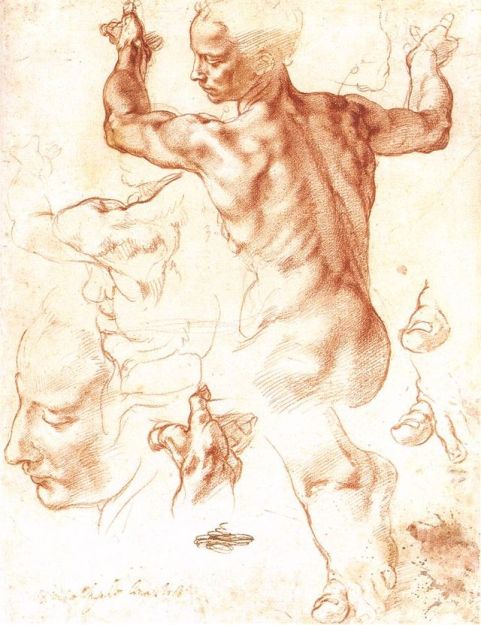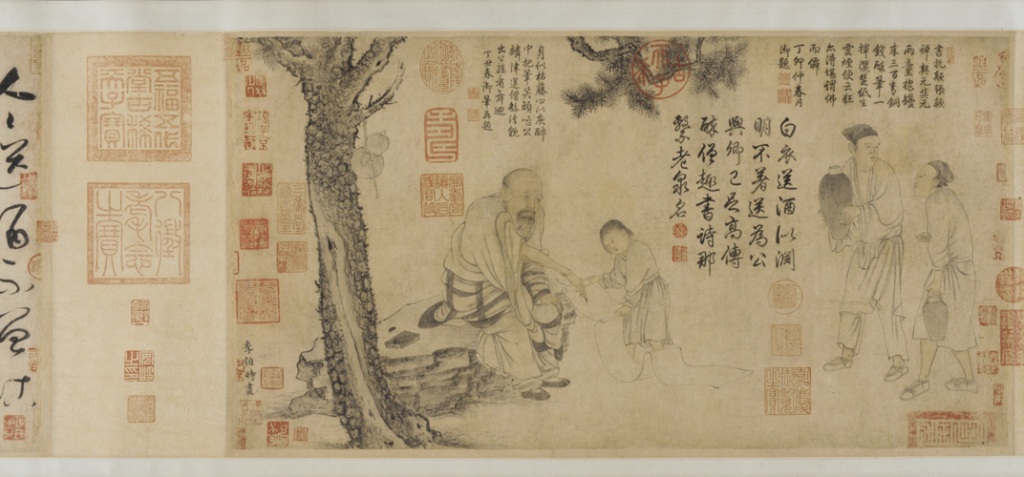 Paper and the pulp-making process is said to have developed in China in the 2nd century A.D. Before that, the Chinese produced ink drawings and paintings on silk. The process of making paper spread from China, through the Middle East, and into Europe by the 13th century. Some of the most beautiful examples of drawing during this time can be found in the practice of calligraphy, which is a type of artful writing done with a brush or pen.
Paper and the pulp-making process is said to have developed in China in the 2nd century A.D. Before that, the Chinese produced ink drawings and paintings on silk. The process of making paper spread from China, through the Middle East, and into Europe by the 13th century. Some of the most beautiful examples of drawing during this time can be found in the practice of calligraphy, which is a type of artful writing done with a brush or pen.
European Monasteries from the 7th to 15th centuries produced beautiful, hand illustrated manuscripts filled with calligraphy on vellum or parchment made from animal hides. One of the oldest examples of the illuminated manuscript is the Codex Vaticanus, which has been dated to the 4th century.
Drawings were preparatory studies and practice for beginning artists so they could eventually paint with accuracy. The illuminated manuscripts are the closest we get to drawing since the prehistoric artists, until the early Renaissance.
In order to keep the lettering and images consistent in these manuscripts, model books were made. These books contained examples or prototypes of what certain images, like the crucifixion, or the martyrdom of Saint George, should look like. Students would copy from the book to learn the style of that particular Atelier, or studio where the books were produced. Each Atelier had their own particular style. After copying all the drawings in the book, they would then be able to produce that style over and over again for the Atelier.
 In about the 13th century, papermaking techniques arrived in Europe. Making paper was easier and less time consuming than stretching, cleaning, and drying animal hides for vellum and artists began using paper more and more frequently. Even still, drawings weren’t considered fine art. Due to the lack of reverence paid them as well as poor conservation, not many drawings still exist from this time period.
In about the 13th century, papermaking techniques arrived in Europe. Making paper was easier and less time consuming than stretching, cleaning, and drying animal hides for vellum and artists began using paper more and more frequently. Even still, drawings weren’t considered fine art. Due to the lack of reverence paid them as well as poor conservation, not many drawings still exist from this time period.
In the Renaissance (ca. 1330 – 1550 CE), drawing became much more popular than in previous centuries and was considered the foundation for any work in the arts. Before students could learn to paint, sculpt, or build, they first had to learn to draw accurately. During this time period, artists began to draw from the live nude figure for the first time and because of this, figures in drawings and paintings developed greater realism.
Drawings weren’t done exclusively on paper; mural artists would draw their composition onto plaster first before painting it. Making multiple studies helped the artist work out any trouble areas before drawing it at a massive scale (if you can’t draw it small, you won’t be able to draw it big either).
Some artists would draw out their composition on a large piece of sturdy paper (like lightweight cardboard) and poke small holes along all their lines. Then they would hold it up to the wall and strike it with a bag full of charcoal, so when the paper was removed, they would have a perfect outline of their drawing on the wall. This is called a cartoon.
Fifteenth-century Flemish artists preferred the precision of metalpoint on white paper. This technique is done by preparing a sheet of paper with a primer or gesso then drawing with a piece of metal (usually silver, though copper and gold are also used) instead of graphite.
When people first discovered graphite in the early 1500’s, they thought it was a type of lead compound, which is why to this day we still call it a “pencil lead” even though there is absolutely no lead in it. In fact, modern pencil leads are a mixture of graphite powder and clay that are then fired in a kiln. By varying the ratio of clay to graphite, the hardness of the pencil changes.
In the 17th and 18th centuries, the importance of absolute precision and accuracy in drawing gave way to a freer handling that reflected the interests of the Baroque style in art. The art of the Baroque was exaggerated to produce drama and grandeur and was intended to impress viewers.
The Rococo period was dominated by French taste and culture. Artworks from this time period are characterized by cheerful, often frivolous subjects and activities, with an emphasis on decoration and luxury. Whereas the Baroque period favored bold lines and dramatic scenes, artworks from the Rococo period are often very soft and gentle in their nature. Line work is less harsh and pastels were used frequently to further enhance this new aesthetic.


Leave a comment